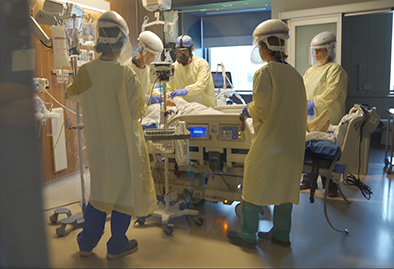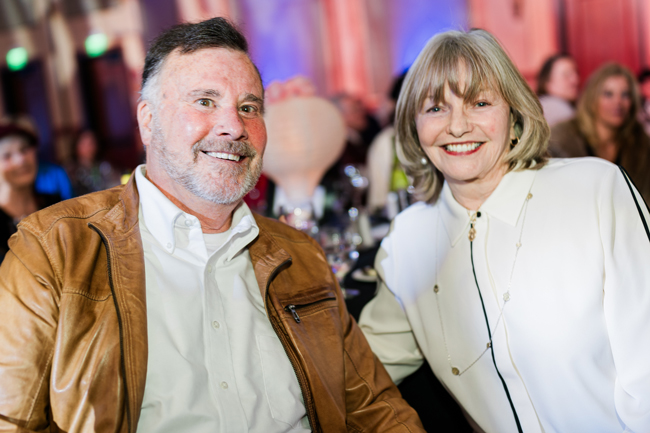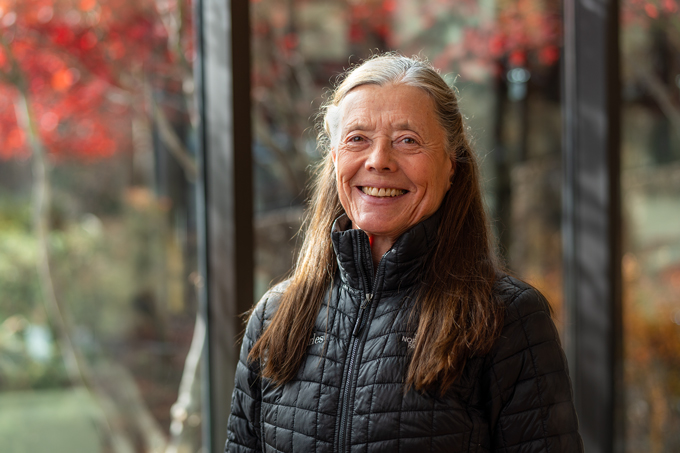It’s been two and a half years since St. Charles Health System expanded its Bend hospital, opening a new patient tower that houses a 24-bed Intensive Care Unit, a 28-bed Progressive Care Unit and open space for future development.
The $66 million addition would’ve been critically helpful in normal times. Because of the COVID-19 pandemic, however, the past 18 months have been anything but normal at St. Charles Bend.
“This tower was badly needed even before COVID,” said Monica Schulz, who manages the Bend ICU, which moved out of a cramped and outdated space when the hospital expanded. “The fact that it was completed and opened just months before the pandemic – well, that turned out to be absolutely crucial timing.”
As soon as it opened, the three-story tower helped alleviate some of the Bend hospital’s ongoing capacity challenges, which stem from a number of factors, including Central Oregon’s fast-growing population. In 2018 alone, the Bend ICU was forced to transfer nearly 100 patients to other facilities for care because of lack of space. Moving into the new tower resulted in a net gain of 33 patient beds, and transfers plummeted in 2019 and 2020, Schulz said.
By early 2020, however, officials at St. Charles were preparing for COVID-19, and the importance of the new patient tower came clearly into focus, Schulz said.
“When we looked at the potential impact of the virus on our facility and our caregivers, it was really obvious that the features we had built into the ICU and the PCU were going to be vital as we worked through this pandemic,” she said. “It has been a learning experience, but the bottom line is our hospital’s response to COVID-19 benefited greatly from the new tower.”
The spacious, state-of-the-art tower has strengthened St. Charles’ COVID response in a number of different ways:
Increased capacity
Throughout the pandemic, the Bend hospital has housed hundreds of COVID-positive patients, ranging from a handful at any given time up to 100 during the recent surge caused by the Delta variant. Many of those patients spend time in the PCU, and the sickest are placed in the ICU, so the added beds in both units have been much-needed – especially considering that the sickest COVID patients often stay in the hospital for weeks.
“We’ve been running at capacity or beyond for many weeks now,” said Debbie Robinson, the hospital’s chief nursing officer. “It has been a constant challenge trying to take care of everyone who comes through our doors, and I can’t imagine how much harder it would’ve been without our new units in the tower.”
Flexibility throughout the hospital
Officials at St. Charles Bend work hard to optimize patient flow throughout the hospital by reducing bottlenecks and placing people where they can receive the most appropriate care.
An important tool in that effort is the hospital’s new Short Stay Unit, which provides patients who will stay for less than 24 hours a place to recover. With 17 new patient rooms, shared space and a central location within the hospital, the SSU is shortening wait times, increasing safety and alleviating capacity concerns in the Emergency Department and elsewhere.
Better patient experience
The rooms in the ICU and PCU are about 44% larger than they were before the expansion – large enough to accommodate more friends and family as well as larger teams of caregivers. They also feature large windows that allow in a lot of natural light, and many offer an excellent view of the Cascade mountains. Special design elements such as “nurse servers” – drawers accessible from both inside and outside rooms – allow caregivers to stock needed items without disturbing patients.
And while visitors have been restricted during the pandemic, caregivers discovered an unanticipated benefit of the new space: COVID patients at end-of-life could be taken out of their rooms to a patio area so their loved ones could be present in their final moments. “That has been such a gift, to give family a chance to say goodbye in a meaningful way,” Schulz said. “We’ve had at least 20 patients pass away out there, and that would not have been possible in the old ICU.” (Unfortunately, the Delta variant ended this practice, she said.)
Improved visibility
A multi-disciplinary group of St. Charles caregivers spent many hours planning and designing the new ICU and PCU in an effort to provide the ideal care environment. Today, that effort comes to life in the units’ nursing stations, which are located in a central area between patient rooms, with windows placed specifically to give caregivers direct line-of-sight to patients. In other words, nurses can easily keep an eye on all their patients at all times.
“This has been especially important during the pandemic, when we need to try to consolidate our trips into patient rooms in order to save time, energy and personal protective equipment,” said Don Jacobs, manager of the PCU. “In the old space, nurses’ computers were on rolling carts in hallways, with limited visibility into the rooms. This is such a huge improvement that protects both our patients and our caregivers.”
Also protecting caregivers: The new ICU’s lift system for transport of heavy patients. As of November, the unit has had only a couple of caregiver injuries resulting from lifting patients, even though patients with COVID-19 require regular “proning,” or turning over from their back to their belly and back again. “That is all manual work,” Schulz said, and the lifts have “helped immensely.”
More rested caregivers
In the old space, caregivers needing a break had to hole up in a small office or walk through the hospital to find a quiet spot. The new tower is fitted with “respite rooms” that provide tired caregivers with kitchen facilities, plenty of space, large windows and mountain views.
“We are always telling our people, ‘Take care of yourself so you can take care of this community,’” Robinson said. “That’s not just something we say, it’s something we believe, because it’s absolutely true. We need our caregivers to be rested and ready to handle whatever comes their way, and those respite rooms give them a wonderful place to go and reflect and recharge.
“That’s always important, and it’s become even more important over the past couple of years,” she continued. “I know everyone here is grateful for that space and for all the many ways this new tower has helped us navigate these challenging times.”





